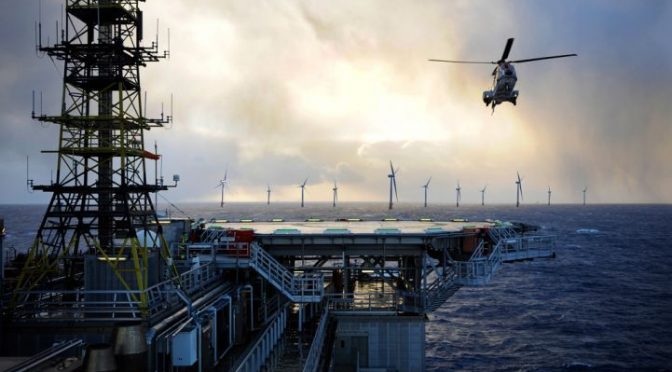The 88 megawatt (MW) wind power project, called Hywind Tampen, consisting of 11 wind turbines, would meet about 35% of electricity needs at the Gullfaks and Snorre.
Equinor will invest close to 5 billion Norwegian crowns ($549 million) to build floating wind turbines that will supply power to several North Sea oil and gas platforms, the first such project of its kind.
In 2017, Equinor built what stands as the world’s largest floating wind project, the 30-megawatt Hywind pilot project off Scotland. That project required NKr 2 billion of investment ($223 million, or around $7.4 million per megawatt), built in water depths of around 100 meters.
Top Articles
Most traditional foundations only work in water depths of up to 60 meters or so.
Hywind Tampen will be built between Norway’s Snorre and Gullfaks oil fields, located 140 kilometers from the coast and in water depths of 260 to 300 meters. The project will consist of 11 turbines, rated at 8 megawatts each, based on Equinor’s own Hywind technology.
Rather than sending power to the shore, as the Hywind pilot does, it will directly serve the oil platforms providing 35 percent of their annual supply.
“About 80 percent of the global resource potential for offshore wind is in deep waters, and floating offshore wind may play an important part in the energy transition towards more sustainable global energy supply,” Equinor CEO Eldar Sætre said in a statement.
State-owned investment fund Enova is providing almost half the funds for the project, which will be completed in 2022.
The oil fields will be operational until at least 2036 (Gullfaks) and 2040 (Snorre). Equinor did not immediately respond to questions about the turbines’ future beyond those dates.
The floating opportunity
Although still expensive, floating offshore technology holds several long-term advantages. Most obviously, floating turbines can operate in deeper waters, opening up new territories to offshore wind, not least the U.S. West Coast.
As it stands France and the U.K. have been the sector’s first movers.
Deeper waters farther out to sea also typically mean better wind conditions. The Hywind II trial has been achieving capacity factors in excess of 65 percent. Conversely, being further out increases cable costs and complicates O&M.
Hywind Tampen will benefit from providing its power to the relatively nearby oil and gas platforms rather than running long and expensive cables back to the coast.
The levelized cost of electricity will plummet below €40 ($44) per megawatt-hour towards 2030, according to Wood Mackenzie forecasts released last year. That’s a little lower than the £40 ($51) per megawatt-hour strike prices achieved in the most recent offshore wind auctions in the U.K. The research firm highlights the technology’s potential near Hawaii and the west coast of the US, Japan, Portugal, Turkey, Norway, U.K., the French Atlantic coast and South Korea.
Equinor is working with South Korea’s national oil company to explore opportunities for floating offshore wind.
MHI Vestas weighs in
Earlier this week MHI Vestas confirmed it would provide three 9.5-megawatt turbines for a trial off the coast of France. This pilot project could have greater influence beyond Europe.
“The oceanic conditions we see in the West of France are representative of 80 percent of global floating potential, so we look forward to delivering our technology to France and leveraging our experience for future floating projects,” MHI Vestas CEO Philippe Kavafyan said in a statement.
The trial is the company’s third floating trial after WindFloat Atlantic in Portugal and Kincardine in Scotland.


